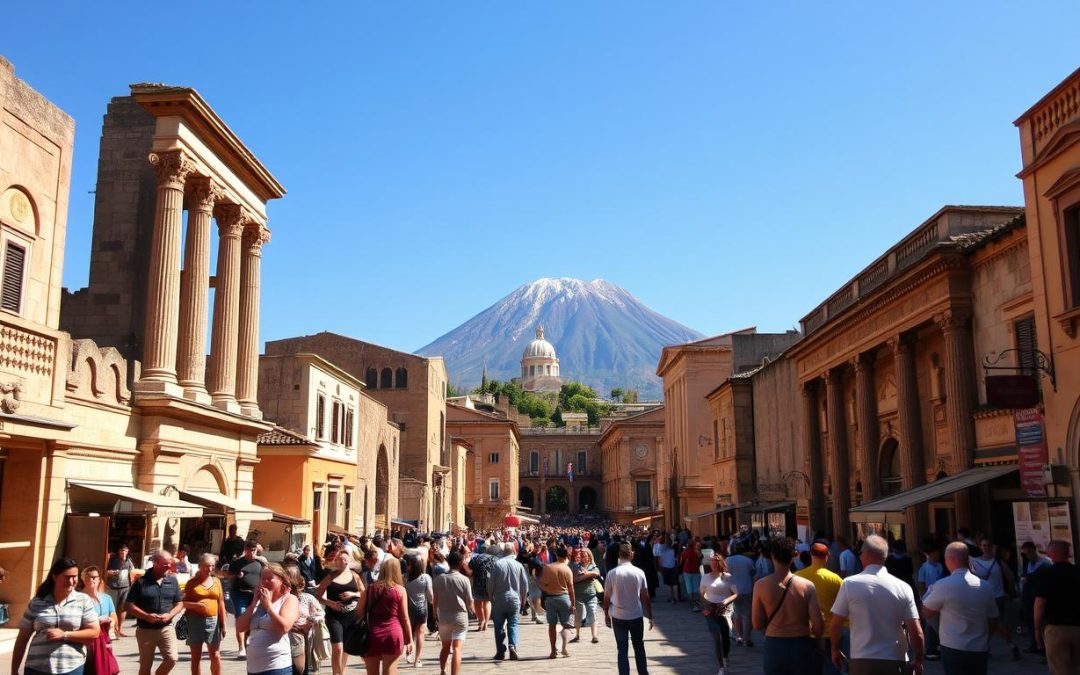Have you ever wondered what daily life was like in an ancient Roman city? Imagine walking through streets frozen in time, where every corner tells a story of a civilization abruptly halted by nature’s fury. This is exactly what you’ll experience when visiting Pompeii, a city preserved under layers of ash from Mount Vesuvius’s eruption in 79 CE.
Once a bustling hub, Pompeii offers a rare glimpse into the past. From the grandeur of the Forum to the intimate details of private villas, every ruin speaks volumes about Roman culture. The city’s well-preserved structures, like the House of the Vettii, showcase intricate frescoes and architectural marvels.
Exploring Pompeii is like stepping into a time capsule. Whether you’re marveling at the Amphitheatre or reflecting on the Garden of the Fugitives, you’ll feel connected to history in a profound way. This guide will help you navigate the site, uncover hidden gems, and make the most of your visit.
Key Takeaways
- Pompeii offers a unique look into ancient Roman life, preserved by Mount Vesuvius’s eruption.
- Key attractions include the Forum, private villas, and the Amphitheatre.
- Plan your visit with at least 2-3 hours to explore the extensive ruins.
- Comfortable shoes are essential for navigating the uneven terrain.
- Purchase tickets in advance to avoid long lines.
A Glimpse into Pompeii’s Rich Historical Legacy
Step into a world frozen in time, where history whispers through ancient ruins. The eruption of Mount Vesuvius in 79 CE was a tragedy that left an indelible mark on this once-thriving Roman city. Yet, it also preserved a snapshot of daily life, offering us a rare window into the past.
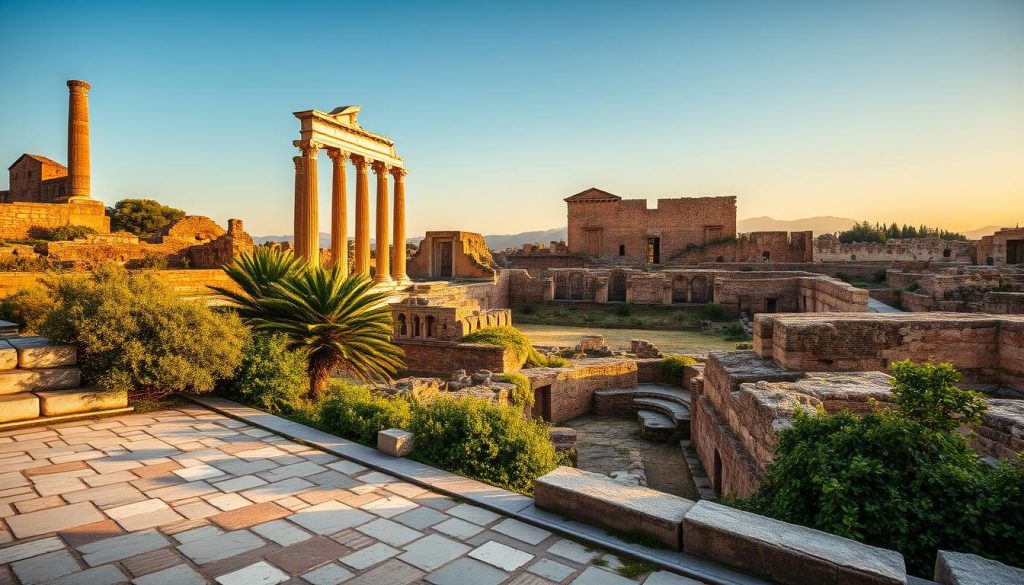
The Impact of Mount Vesuvius’s Eruption
The eruption buried the city under 4-6 meters of ash, freezing it in time. This rapid ashfall preserved buildings, frescoes, and artifacts in remarkable detail. “It’s as if the city paused mid-breath,” one historian noted. The ruins provide invaluable insights into Roman culture, from their architectural ingenuity to their daily routines.
Today, walking through the site feels like stepping into a time capsule. You’ll see everything from grand public baths to intimate private homes, each telling a story of life before the disaster. The preservation of these structures is a testament to the power of nature—and its role in shaping history.
Rediscovery and Ongoing Excavations
Excavations began in 1748 and continue to this day, uncovering new details about the city’s former vibrancy. Archaeologists have unearthed everything from intricate mosaics to everyday household items, painting a vivid picture of Roman life. Over 160 acres of the site have been explored, yet much remains hidden beneath the ash.
For visitors, the Porta Marina entrance is the ideal starting point. From here, you can explore hidden areas and key attractions. Make sure to plan your day carefully, as the site is vast and filled with wonders. Trains from Naples offer convenient access, making it easy to include this journey in your itinerary.
Pompeii’s transformation from a bustling Roman city to a preserved archaeological site is a story of loss and discovery. As you wander its streets, you’ll feel a profound connection to the people who once called this place home.
Key Attractions and Must-See Roman Ruins
Discover the heart of ancient Roman civilization through its most iconic ruins. From grand public spaces to intimate private homes, each site tells a story of life before the catastrophic eruption of Mount Vesuvius. These ruins are not just remnants of the past—they are windows into a vibrant world frozen in time.
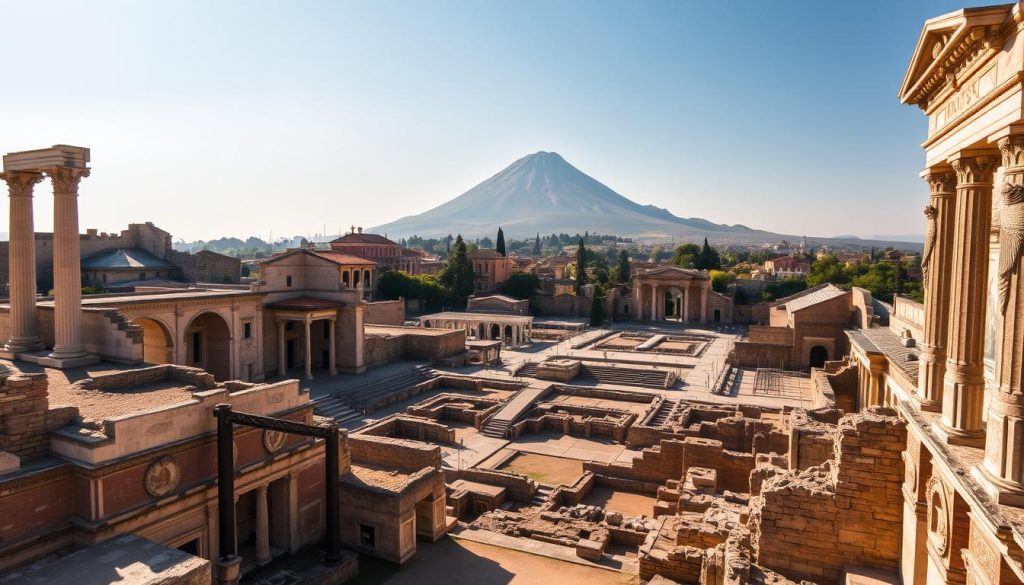
Exploring Iconic Sites: Forum, Baths, and Amphitheater
The Forum was the epicenter of civic life, where citizens gathered for political, social, and commercial activities. Today, it offers expansive views of preserved public spaces, making it a must-see for history enthusiasts. “Walking through the Forum feels like stepping into the heart of ancient Rome,” one visitor remarked.
Nearby, the public baths showcase Roman ingenuity in engineering and social life. These spaces were more than just places to bathe—they were hubs of relaxation and conversation. The amphitheater, Rome’s oldest surviving stone structure, is another highlight. It once hosted gladiatorial games and could seat thousands of spectators.
Private Villas and Hidden Treasures
Beyond the public spaces, private villas like the House of the Faun reveal the opulence of Pompeii’s wealthy citizens. These homes are adorned with intricate mosaics and delicate frescoes that bring ancient life into focus. Each villa offers a glimpse into the luxurious lifestyle of its former residents.
Exploring these hidden treasures requires time and curiosity. Many villas are tucked away in quieter corners of the site, offering a peaceful escape from the more crowded areas.
| Attraction | Highlights | Tips |
|---|---|---|
| Forum | Civic center, preserved public spaces | Visit early to avoid crowds |
| Baths | Engineering marvels, social hubs | Bring water and wear comfortable shoes |
| Amphitheater | Oldest stone structure, gladiatorial games | Capture panoramic views from the top |
To make the most of your visit, purchase tickets in advance. This will save you time and ensure a smoother experience. The site covers over 160 acres, so plan to spend at least 4-5 hours exploring its wonders.
Essential Visitor Experiences in Pompeii
Feel the echoes of the past as you explore the ancient pathways of a once-thriving city. Walking through these streets is more than just sightseeing—it’s a journey through time. The labyrinth-like layout invites you to discover hidden corners and marvel at the intricate details of Roman life.
Wandering the Ancient Streets on Foot
There’s no better way to connect with the rich history of this place than by walking its streets. As you stroll, you’ll notice the preserved cobblestones, ancient doorways, and remnants of daily life. “Every step feels like a conversation with the past,” one visitor shared. Take your time to absorb the scale and craftsmanship of Roman innovations.
Spend an hour at key highlights like the Forum or the Amphitheater. These sites offer a deeper understanding of the city’s grandeur. Comfortable shoes are a must, as the terrain can be uneven. Trains from Naples make it easy to reach the site, so you can focus on the experience.
Immersive Cultural Encounters and Guided Tours
To truly appreciate the nuances of this historic site, consider joining a guided tour. Expert guides bring the ruins to life with stories and insights into Roman architecture and culture. Companies like Take Walks offer engaging tours that highlight key areas and reduce the chances of getting lost.
These tours often include historical narratives and anecdotes that make the experience richer. Guided tours typically last around 2 hours, but you can extend your visit to explore further. Combining self-guided exploration with professional insights ensures a well-rounded cultural encounter.
- Wander freely to discover hidden gems and personal connections.
- Join a guided tour for expert insights and historical context.
- Spend time at key sites to appreciate the craftsmanship and scale.
- Use both self-guided resources and professional guides for a comprehensive experience.
Handy Tips for a Smooth and Enjoyable Visit
Planning your trip to this historic site? Here’s how to make it seamless and enjoyable. With a little preparation, you can avoid the crowds, stay comfortable, and fully immerse yourself in the experience.
Strategies for Avoiding Crowds and Navigating the Site
Arriving early is one of the best ways to beat the crowds. The site opens at 9:00 AM, and getting there right at opening ensures a quieter experience. Exploring less frequented areas, like the secluded garden or the brothel, can also provide a more peaceful visit.
Detailed maps are essential for navigating the sprawling ruins. They help you locate key attractions and plan your route efficiently. “Having a map saved us so much time,” shared one visitor. If you prefer guidance, consider hiring a local expert to lead the way.
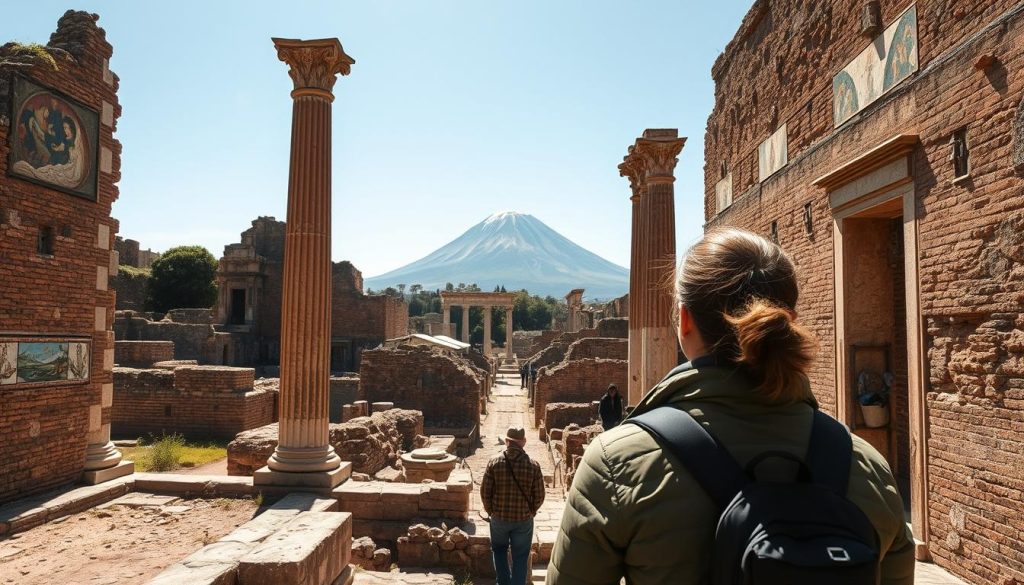
What to Pack and How to Stay Comfortable
Comfort is key when exploring uneven terrain. Wear sturdy shoes to navigate the ancient building grounds safely. Bring plenty of water, especially during warmer months, as the site can get hot and dusty.
Pack sunscreen, a hat, and snacks to keep your energy up. Purchasing tickets in advance is another smart move to avoid long lines at the entrance. This allows you to focus on the experience rather than waiting in line.
For families, strollers can be challenging on cobblestone paths, but main routes are manageable. Consider the stroller-friendly itinerary for a smoother visit. Staying comfortable ensures you can fully enjoy the day without unnecessary stress.
Getting There: Transportation and Entry Insights
Traveling to this ancient site is easier than you might think. Whether you prefer the convenience of public transport or the flexibility of driving, there are options to suit every traveler. Here’s what you need to know to plan your trip smoothly.
Train vs. Car: Best Ways to Reach the Site
The Circumvesuviana train from Naples is the most popular choice. It’s affordable, frequent, and takes just 45 minutes to reach the Pompei Scavi station. From there, it’s a short walk to the entrance, making it a hassle-free option. “The train is reliable and drops you right at the doorstep,” one traveler shared.
If you prefer driving, keep in mind that parking can be limited. The site’s extensive park area has official lots, but they fill up quickly, especially during peak hours. Driving offers flexibility, but the stress of finding a spot might outweigh the benefits.
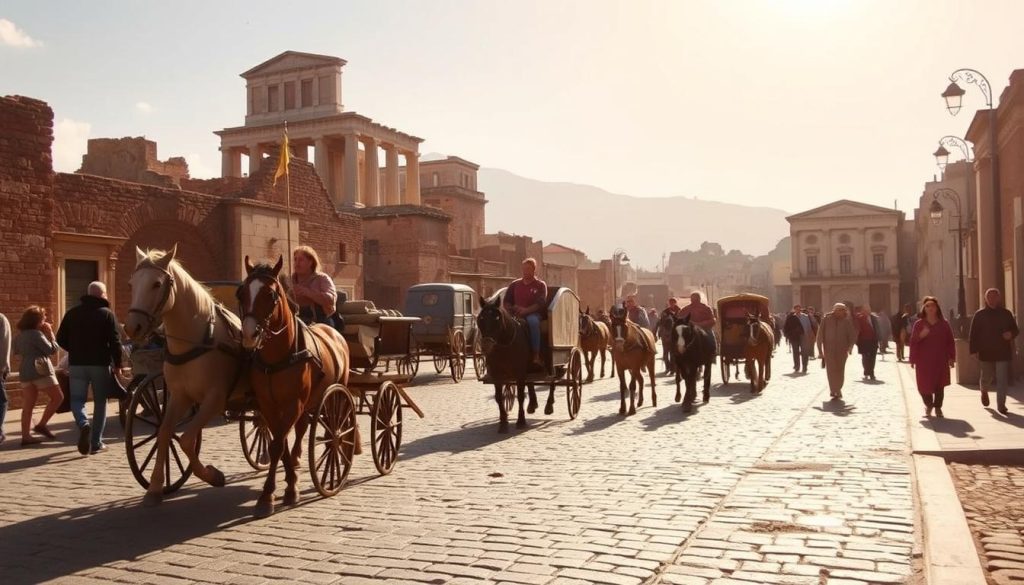
Practical Tips for a Smooth Journey
Here are some tips to make your trip seamless:
- Book tickets in advance: Avoid long lines by purchasing your entry pass online.
- Check train schedules: The Circumvesuviana runs frequently, but it’s wise to plan your departure time.
- Arrive early: Beat the crowds by getting to the site as soon as it opens.
- Consider public transport: It’s eco-friendly and avoids the hassle of traffic and parking.
| Option | Pros | Cons |
|---|---|---|
| Train | Affordable, frequent, close to entrance | Can be crowded during peak times |
| Car | Flexible, convenient for groups | Limited parking, traffic challenges |
Whether you choose the train or car, planning ahead ensures a stress-free experience. Public transport is highly recommended for its convenience and ease of access. With these tips, your journey to this historic site will be as memorable as the destination itself.
Pompeii, Italy: Best Things to Do – Top Picks: A Detailed Itinerary
Crafting the perfect day exploring ancient ruins requires careful planning and timing. With so much to see, a structured itinerary ensures you make the most of your visit while avoiding the crowds. Here’s how to plan your day from morning to afternoon, with insider tips to enhance your experience.
Highlights from Morning to Afternoon
Start your day early to beat the crowd and enjoy the site at its quietest. Arrive by 9:00 AM to explore key attractions like the Forum and the Amphitheater before they get busy. These sites are must-see highlights that offer a glimpse into the city’s grandeur.
Mid-morning, head to the House of the Vettii or the House of the Faun. These private villas showcase intricate mosaics and frescoes, giving you a deeper understanding of Roman life. Book an audio guide to enrich your visit with historical context and fascinating stories.
Afternoon is the perfect time to explore hidden gems like the Garden of the Fugitives or the Lupanar. These lesser-known spots are often less crowded, allowing you to absorb the historical ambiance at your own pace. Take breaks at designated rest areas to recharge and reflect on the day’s discoveries.
Insider Recommendations and Unmissable Spots
To make the most of your visit, consider joining a guided tour. Expert guides provide in-depth insights and help you navigate the sprawling site efficiently. “A guided tour transformed my visit,” shared one traveler. Book in advance to secure your spot and avoid last-minute hassles.
Allocate extra time at the Amphitheater, one of the oldest of its kind in the world. Its sheer scale and historical significance make it a highlight of any visit. For a more intimate experience, explore the quieter corners of the site, where you’ll find beautifully preserved frescoes and artifacts.
- Start early to avoid the crowd and enjoy key attractions in peace.
- Use an audio guide or join a guided tour for deeper historical insights.
- Spend extra time at the Amphitheater and private villas for a richer experience.
- Explore hidden gems like the Garden of the Fugitives for a quieter, more personal connection to history.
By planning your day carefully and booking essential elements in advance, you’ll ensure a smooth and memorable visit. Whether you’re marveling at grand public spaces or discovering intimate private homes, this itinerary guarantees a day filled with unforgettable highlights.
Conclusion
Walking through the ancient streets, you’ll feel a deep connection to a world preserved by nature’s force. The ash from Mount Vesuvius’s eruption froze this city in time, offering a rare glimpse into daily life centuries ago. Every thing you see—from intricate frescoes to grand public spaces—tells a story of resilience and legacy.
Each year, millions of visitors are drawn to this site, captivated by its timeless appeal. As you explore, take a moment to reflect on the lives shaped by this place. The preserved ruins are not just remnants of the past; they are windows into a vibrant culture that continues to inspire.
Your journey here is more than sightseeing—it’s an immersive experience. Every step deepens your understanding of ancient life, from architectural marvels to cultural anecdotes. Plan to return, as there’s always more to discover in this timeless treasure trove.
The above is subject to change.
Check back often to TRAVEL.COM for the latest travel tips and deals.
Here are some Tours & Sightseeing suggestions that might pique your interests!
